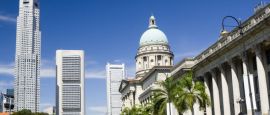Singapore History
It might look ultra-modern but Singapore is a city with a history that dates back almost two millennia. Although given a mention by Ptolemy in the 2nd century and later by a 3rd-century Chinese manuscript, it wasn’t until another 1,000 years later that Singapore properly began.
In 1299, the Kingdom of Singapura was founded by Sang Nila Utama, a prince from Palembang in Indonesia. After spotting a lion, he concluded that the island was a perfect spot for a city, which he promptly named Singapura (Lion City). Despite Utama’s high hopes, the growing settlement was repeatedly dragged into conflicts among the Malay sultanates, Siamese kingdoms and Indian empires until the British arrived in 1819.
First through the door was globe-trotting adventurer Thomas Stamford Raffles, who claimed Singapore for the British East India Company. Recognising its maritime potential, he invited settlers to relocate to the area and by 1880, 1.5 million tonnes of goods were passing through the city each year. By the turn of the century, Singapore had become one of the most important cities in the British Empire, albeit one with a reputation for colourful (and often illegal) goings-on in poorer parts of town.
But dark clouds were on the horizon and although it was unscathed during WWI, it wouldn’t be so lucky the second time around. In December 1941, the invading Japanese landed on the Malaya Peninsula and just under two months later, Singapore surrendered and a three-year occupation (marked by the ruthless brutality of the Japanese forces) began. Finally liberated in August 1945, governance was taken over by a military council before elections were held in 1948.
Singapore was part of Malaysia when they were given independence in 1959, but it later took control of its own destiny and declared independence from Malaysia in 1965. After a number of teething problems, Singapore began to boom, with the pace picking up in the 1980s and 90s. Today, the city is a global commerce, finance and transport powerhouse.
Did you know?
• The Cloud Forest in the Gardens by the Bay houses the world’s tallest indoor waterfall at 35m (115ft).
• Singapore has 63 offshore islands surrounding the main island with Sentosa being the largest.
• The Irishman George D. Coleman became Singapore’s first official architect from 1833. His Palladian style set the tone for the city’s early development.
Do you have any Feedback about this page?
© 2025 Columbus Travel Media Ltd. All rights reserved. No part of this site may be reproduced without our written permission, click here for information on Columbus Content Solutions.




 You know where
You know where